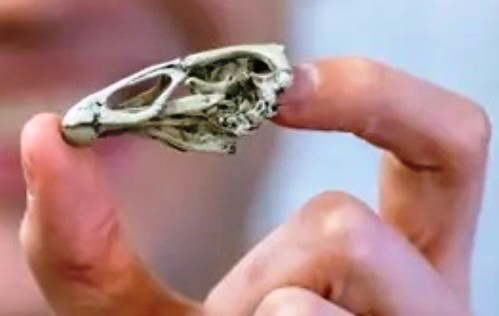Scientists have identified the earliest known fossil of a modern bird. The fossil remains—comprising an almost-complete skull and a few limb bones embedded in rock—were discovered in a limestone quarry in Belgium. Estimated to be approximately 66.7 million years old and named Asteriornis maastrichtensis (subclass Neornithes, class Aves), recent analyses of the anatomical features of this diminutive fossil avian (which weighed about 400 g, or about the weight of a very small teal or quail) led investigators to declare it to be the oldest known common ancestor of today's land fowl (chickens and chickenlike birds, order Galliformes) and waterfowl (ducks and ducklike birds, order Anseriformes). Because of the anatomical resemblance of the fossil bird to various fowl, particularly chickens, investigators have assigned the nickname of Wonderchicken to this species. See also: Anseriformes; Aves; Fossil; Galliformes; Neornithes

Identification of the 66.7 million-year-old A. maastrichtensis is notable because it provides fossil evidence of a modern-type bird that lived at least slightly before, and survived through, the end-Cretaceous mass extinction event. This event, which occurred 66 million years ago, was likely precipitated by the Chicxulub asteroid impact off the Yucatán Peninsula in Mexico that wiped out nonavian dinosaurs. In fact, the assigned genus name Asteriornis refers to Asteria, who was the Greek Titan goddess of falling stars. As the avian fossil record is quite sparse from this ancient time period (especially with regard to avian fossils in Europe), the discovery of A. maastrichtensis should furnish insights concerning the evolution and divergence of modern-day birds. Most importantly, the fossil discovery reveals that genealogical lineages of living fowl had evolved by at least 66.7 million years ago. Scientists estimate that the first modern-day birds emerged possibly 70 million years ago (other estimates, though, indicate older dates, up to 110 million years ago). If the more-recent timeline is accurate, then the A. maastrichtensis discovery (with an age of 66.7 million years) places the fossil bird relatively close in time to the initial common ancestor of all modern birds. See also: Avian evolution; Chicxulub impact crater; Cretaceous; Extinction
Using high-resolution X-ray computerized tomographic (CT) scans of the marine sedimentary rock that contained the fossil remains (which mostly were buried about 1 mm under the outer surface of the rock), paleontologists were able to observe a remarkably well preserved bird skull, as well as fragmentary remains of leg bones and a radius (forearm bone). Some of the fragmentary bone parts were protruding out of the rock, which led to the Wonderchicken's discovery; otherwise, investigators may not have realized the significance of that particular rock. CT scans indicated that A. maastrichtensis did not possess teeth, which is a key feature of modern birds. More ancestral birds or birdlike creatures—such as the well-studied Archaeopteryx, which lived 150 million years ago—had teeth and thus are not deemed to be immediate ancestors of modern birds. In addition to the lack of teeth, other anatomical features of the skull indicate that A. maastrichtensis was an early ancestor of modern chickens (Galliformes) or ducks (Anseriformes); however, the skull features were not determinative enough to assign A. maastrichtensis closer to either the Galliformes or Anseriformes lineage. Lastly, the discovery of long, slender leg bones of A. maastrichtensis within a marine sedimentary rock suggests that this species inhabited seashores during the end of the Cretaceous Period. See also: Archaeopteryx; Computerized tomography; Cretaceous bird radiation





